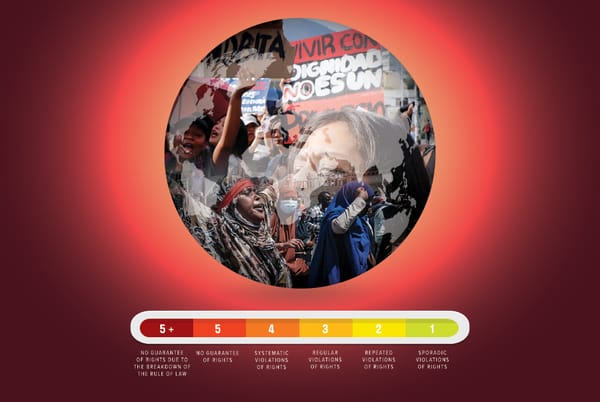The latest Labour Force Survey results arrived May 6, giving a picture of the state of the labour market for April 2022. While unemployment is low and wages are growing, there seems to be little indication that these favourable conditions are translating into growing worker or union power. After another month of rosy reporting, it’s time to ask some deeper questions about the shape of the labour market and the prospect of strengthening the working class.
In April, unemployment decreased slightly to 5.3 per cent, which Statistics Canada refers to as “a record low.” This makes sense only if one forgets that unemployment rates of this level were the norm during the post-war period when governments at least entertained full employment as a policy goal. The adjusted unemployment rate — which includes workers who wanted a job but didn’t look for one — was still 7.2 per cent, while the labour underutilization rate, which includes people who worked fewer than half their usual hours, rose by just under 1 per cent. The so-called “tight” labour market still has noticeable slack.
As well, long-term unemployment continues to be a stubborn issue and remains elevated above its February 2020 level. The long-term unemployed (those out of work for 27 weeks or more) accounted for more than one-fifth of all unemployed people in April. Among this group, more than 66 per cent have been looking for work for a year or more. Some of this may be the result of “skills mismatches” and other structural factors, but nevertheless, a labour market which fails to produce meaningful work for this many people is in need of serious reform.
The employment rate, expectedly, was more or less unchanged in April, sitting at 61.9 per cent. Core-aged women (between 25 to 54 years of age) increased their employment slightly, while core-aged men saw a decline of half a percentage point. This is likely the result of gendered patterns of employment and job growth and losses in April. Professional, scientific and technical services, and public administration positions grew, while jobs were lost in construction. Continuing a pattern observed throughout the recovery, core-aged women are making historic employment gains.
Things are slightly less rosy for workers 55 years and older, however. Although employment rates for both men and women in this group have returned to pre-pandemic levels, those 65 and older but still in the labour force are having a more difficult time attaining the employment they did two years ago.
Although employment is holding steady, hours worked are not. This is unsurprising. Much of the country is now operating as though COVID-19 is of no concern. Predictably, this has resulted in greater illness and absence from work, which has produced a drop of 1.9 per cent in total hours. During April 2022, nearly one in 10 workers were out of work sick. This is the second highest rate of absence due to illness or disability observed during the entire pandemic, just behind the peak of the fifth wave in January of this year.
On the wage front, things are mixed. On the positive side, the number of workers earning less than $20 per hour has dropped considerably during the economic recovery. Overall, there has been a shift upward in the wage distribution, with nearly one in four workers now earning $40 or more per hour. In April 2022, there were 1.3 million fewer workers with hourly wages less than $20 compared to two years prior. Just over one-quarter of workers now earn less than $20, down from 35.5 per cent in April 2019.
On the other hand, overall wage growth continues to lag inflation, meaning that, on average, workers’ purchasing power and living standards are being eroded. Average hourly wages in April were up 3.3 per cent, virtually identical to the previous month’s wage growth. Yet with inflation topping 6.7 per cent in March, workers are facing a net wage loss. (Annual inflation, however, is nearly in line with wage growth.)
While we have heard much from employers and business representatives in the media about a “labour shortage,” I’ve been skeptical about our supposedly tight labour market. It’s true that job vacancies are way up. According to Job Vacancy and Wage Survey data, job vacancies are 80 per cent higher than they were two years ago across sectors, with the most recent job vacancy rate sitting at 1.3 per cent. This is putting some pressure on the bottom end of the wage distribution, and has likely had an impact on wages across the board.
As the LFS puts it: “A number of signs have pointed to an increasingly tight labour market in recent months.” Full-time work is up and holding steady and there has been a decrease in the proportion of part-time workers reporting that they would prefer full-time employment. “The involuntary part-time employment rate fell to 15.7 per cent in April 2022, the lowest level on record,” according to the April LFS.
Moreover, employment rates and patterns are improving for workers frequently marginalized in the labour market. Over the past year, employment among Indigenous men and women has grown by 4.9 and 5.7 percent, respectively. Employment among workers who immigrated to Canada within the previous five years is up nearly 4 per cent. Due to labour market segmentation and discrimination, these workers often find themselves in what Marx referred to as the “reserve army of labour.” That their employment rates have improved to this extent is a sign that the labour market has improved.
However, the amount of wage growth explained by a tight labour supply remains an open question. For example, several provinces have either recently raised their minimum wage rates or have rates that are indexed to national or provincial inflation. This means that part of the wage growth for those earning minimum wage or just above is the result of public policy, not labour market signals.
As I’ve argued previously, this is simply more indication that market forces alone are entirely insufficient to improve workers’ wages and labour conditions. Although the left should unequivocally fight for monetary, fiscal and social policies geared to promoting full employment, generating a tight labour market on its own is only part of the agenda. Public policy interventions, in the forms of raising minimum wages and employment standards and making it easier to join unions, are needed.
The last several Labour Force Surveys provide further evidence of a long-term pattern whereby labour market “tightness” is proving insufficient to improve wages or increase union density. Now that the Bank of Canada is on course to raise interest rates, we can expect to see some loosening of the labour market and a likely consequent decline in both worker bargaining power and upward wage pressure. There’s little appetite among either central bankers or elected leaders for allowing market conditions to redound to the benefit of workers to any great extent.
A look at data on work stoppages — strikes and lockouts — further demonstrates that the so-called “tight labour market” isn’t having any appreciable impact on worker or union militancy. Overall, work stoppages continue their long-term, downward trend.

According to federal government Labour Program data, between 2008 and 2021, there was an average of 174 work stoppages per year, with a peak of 281 strikes in 2012. However, as the above graph indicates, aside from a couple of spikes, the downward slope in strike activity is notable. Granted, data for 2022 are partial, but at 38 strikes thus far, it’s doubtful that we’re in for any strike wave of confident workers exercising conjunctural power in a favourable labour market.
Data from the Labour Force Survey itself also shows no significant growth in hours lost due to “labour disputes” between 2010 and 2022. A minor spike in 2014 likely results from that year randomly having work stoppages of above-average duration.

The other key measure of strike activity — the number of workers out on strike — is looking only marginally better.

Between 2008 and 2021, an average of 171,936 Canadian workers were out on strike annually. However, there has been considerable variation in this figure since 2014, with a peak of more than 624,000 workers out in 2020. Evidently, the difference between the number of annual work stoppages and the number of workers involved means that, recently, larger bargaining units have been striking.
In part, this is an indication of the greater strike propensity of public sector workers — who tend to be members of larger bargaining units — as well as the overall concentration of union membership in the public sector. For example, 613,646 of the 624,028 workers on strike in 2020 were public sector union members. Splitting the strike data by private and public sector workers further illustrates the trend.

Strikes by private sector union members continue to be in the doldrums, with minor breaks in normality here and there. Public sector workers, on the other hand, can have considerable impacts on the total figures for workers on strike. For instance, the 613,646 public sector union members responsible for the considerable peak in workers on strike in 2020 are concentrated in only 25 bargaining units, which is actually a low point for the yearly number of public sector bargaining units out on strike.

This all amounts to a considerable sea change from the late 1970s and early '80s — the high point of Canadian trade union militancy — when relatively strong and sizable private sector unions in manufacturing and resource extraction struck much more frequently and represented a much greater proportion of strikes and workers out on strike annually. These shifts in union membership and strike activity are all the more notable when one considers that the public sector workforce annually accounts for only about 18 to 20 per cent of Canadian employees, lower than European countries with high union density.
A strong public sector with militant unions is a key ingredient to both a strong labour movement and a system of robust public services, but renewed union strength is needed in the private sector as well. A momentarily tight labour market, while potentially helpful in creating a context for union organizing, is insufficient on its own. Unions need to build dedicated organizing programs to bring more private sector workers into the labour moveme







